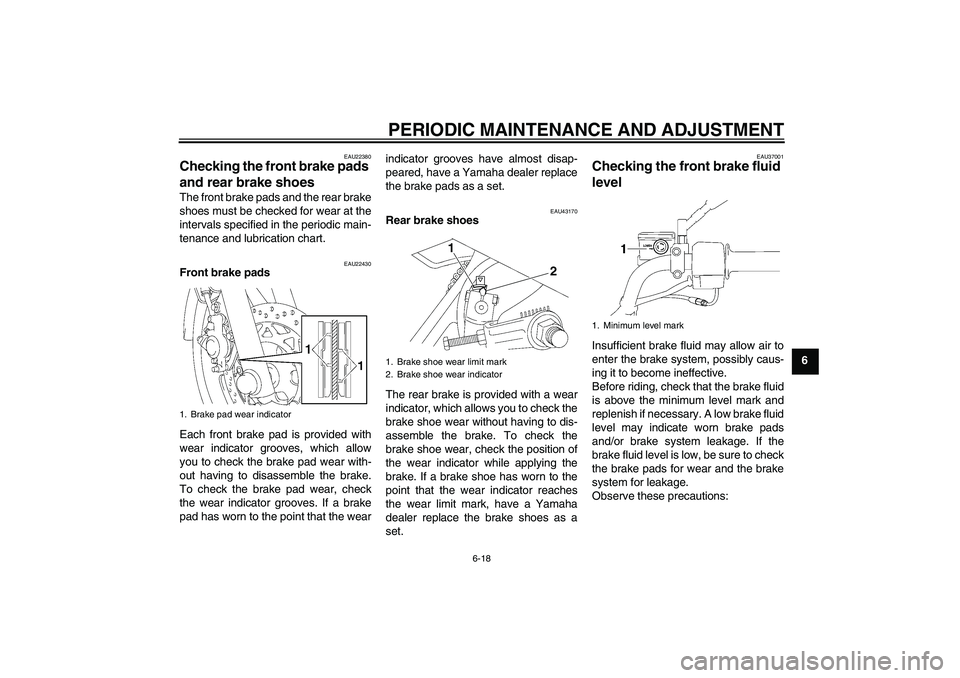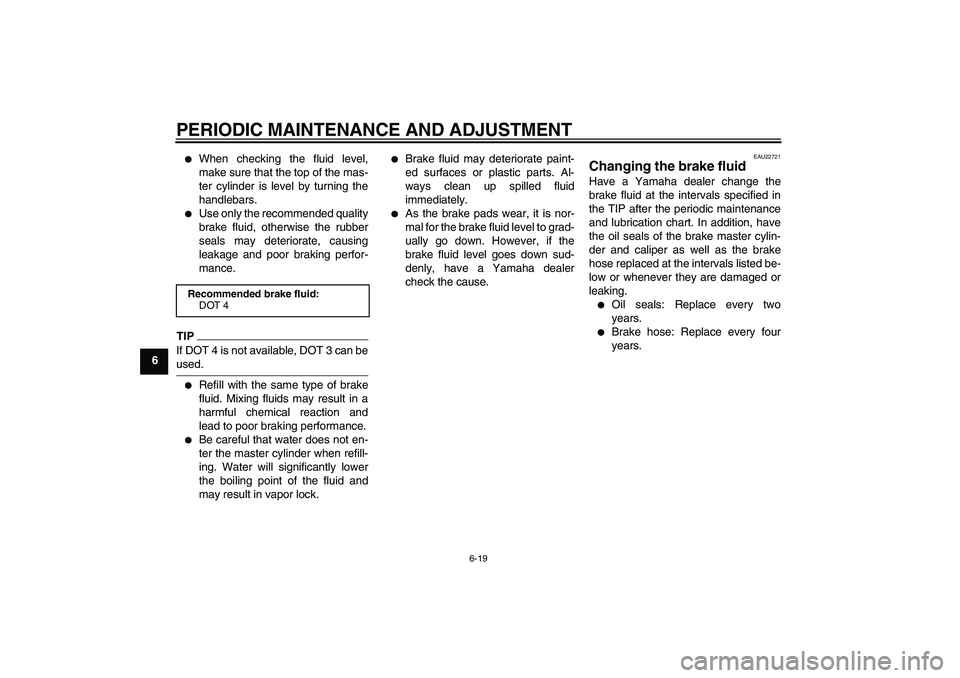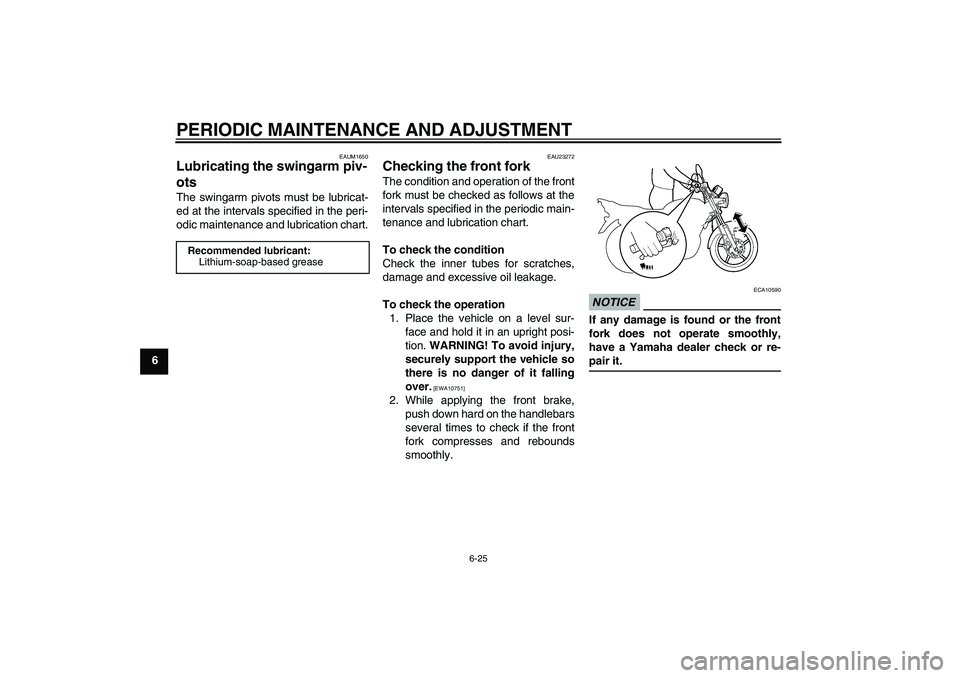Page 49 of 80

PERIODIC MAINTENANCE AND ADJUSTMENT
6-18
6
EAU22380
Checking the front brake pads
and rear brake shoes The front brake pads and the rear brake
shoes must be checked for wear at the
intervals specified in the periodic main-
tenance and lubrication chart.
EAU22430
Front brake pads
Each front brake pad is provided with
wear indicator grooves, which allow
you to check the brake pad wear with-
out having to disassemble the brake.
To check the brake pad wear, check
the wear indicator grooves. If a brake
pad has worn to the point that the wearindicator grooves have almost disap-
peared, have a Yamaha dealer replace
the brake pads as a set.
EAU43170
Rear brake shoes
The rear brake is provided with a wear
indicator, which allows you to check the
brake shoe wear without having to dis-
assemble the brake. To check the
brake shoe wear, check the position of
the wear indicator while applying the
brake. If a brake shoe has worn to the
point that the wear indicator reaches
the wear limit mark, have a Yamaha
dealer replace the brake shoes as a
set.
EAU37001
Checking the front brake fluid
level Insufficient brake fluid may allow air to
enter the brake system, possibly caus-
ing it to become ineffective.
Before riding, check that the brake fluid
is above the minimum level mark and
replenish if necessary. A low brake fluid
level may indicate worn brake pads
and/or brake system leakage. If the
brake fluid level is low, be sure to check
the brake pads for wear and the brake
system for leakage.
Observe these precautions:
1. Brake pad wear indicator
1. Brake shoe wear limit mark
2. Brake shoe wear indicator
1
2
1. Minimum level mark
U3D9E2E0.book Page 18 Thursday, November 6, 2008 10:54 AM
Page 50 of 80

PERIODIC MAINTENANCE AND ADJUSTMENT
6-19
6
�
When checking the fluid level,
make sure that the top of the mas-
ter cylinder is level by turning the
handlebars.
�
Use only the recommended quality
brake fluid, otherwise the rubber
seals may deteriorate, causing
leakage and poor braking perfor-
mance.
TIPIf DOT 4 is not available, DOT 3 can beused.�
Refill with the same type of brake
fluid. Mixing fluids may result in a
harmful chemical reaction and
lead to poor braking performance.
�
Be careful that water does not en-
ter the master cylinder when refill-
ing. Water will significantly lower
the boiling point of the fluid and
may result in vapor lock.
�
Brake fluid may deteriorate paint-
ed surfaces or plastic parts. Al-
ways clean up spilled fluid
immediately.
�
As the brake pads wear, it is nor-
mal for the brake fluid level to grad-
ually go down. However, if the
brake fluid level goes down sud-
denly, have a Yamaha dealer
check the cause.
EAU22721
Changing the brake fluid Have a Yamaha dealer change the
brake fluid at the intervals specified in
the TIP after the periodic maintenance
and lubrication chart. In addition, have
the oil seals of the brake master cylin-
der and caliper as well as the brake
hose replaced at the intervals listed be-
low or whenever they are damaged or
leaking.�
Oil seals: Replace every two
years.
�
Brake hose: Replace every four
years.
Recommended brake fluid:
DOT 4
U3D9E2E0.book Page 19 Thursday, November 6, 2008 10:54 AM
Page 51 of 80

PERIODIC MAINTENANCE AND ADJUSTMENT
6-20
6
EAU22760
Drive chain slack The drive chain slack should be
checked before each ride and adjusted
if necessary.
EAU22793
To check the drive chain slack
1. Place the motorcycle on the cen-
terstand.
2. Shift the transmission into the neu-
tral position.
3. Spin the rear wheel several times
to locate the tightest portion of the
drive chain.
4. Measure the drive chain slack as
shown.5. If the drive chain slack is incorrect,
adjust it as follows.
EAU37113
To adjust the drive chain slack
1. Loosen the brake pedal free play
adjusting nut, brake torque rod nut,
and axle nut.
2. Loosen the chain puller locknut at
each end of the swingarm.3. To tighten the drive chain, turn the
drive chain slack adjusting bolt at
each end of the swingarm in direc-
tion (a). To loosen the drive chain,
turn the adjusting bolt at each end
of the swingarm in direction (b),
and then push the rear wheel for-
ward. NOTICE: Improper drive
chain slack will overload the en-
gine as well as other vital parts
of the motorcycle and can lead
to chain slippage or breakage.
To prevent this from occurring,
keep the drive chain slack with-
in the specified limits.
[ECA10571]
TIPUsing the alignment marks on each
side of the swingarm, make sure that
both chain pullers are in the same posi-tion for proper wheel alignment.
1. Drive chain slack
Drive chain slack:
20.0–30.0 mm (0.79–1.18 in)
1. Drive chain slack adjusting bolt
2. Chain puller locknut
3. Axle nut
4. Brake torque rod nut
5. Brake pedal free play adjusting nut
U3D9E2E0.book Page 20 Thursday, November 6, 2008 10:54 AM
Page 52 of 80

PERIODIC MAINTENANCE AND ADJUSTMENT
6-21
64. Tighten both locknuts, and then
tighten the axle nut and brake
torque rod nut to their specified
torques.
5. Adjust the brake pedal free play.
(See page 6-17.)
WARNING
EWA10660
After adjusting the brake pedal free
play, check the operation of thebrake light.
EAU23023
Cleaning and lubricating the
drive chain The drive chain must be cleaned and
lubricated at the intervals specified in
the periodic maintenance and lubrica-
tion chart, otherwise it will quickly wear
out, especially when riding in dusty or
wet areas. Service the drive chain as
follows.NOTICE
ECA10581
The drive chain must be lubricated
after washing the motorcycle andriding in the rain.
1. Clean the drive chain with kero-
sene and a small soft brush.
NOTICE: To prevent damaging
the O-rings, do not clean the
drive chain with steam cleaners,
high-pressure washers or inap-
propriate solvents.
[ECA11121]
2. Wipe the drive chain dry.
3. Thoroughly lubricate the drive
chain with a special O-ring chain
lubricant. NOTICE: Do not use
engine oil or any other lubri-
cants for the drive chain, as they
1. Alignment marks
2. Chain puller locknut
3. Drive chain slack adjusting boltTightening torques:
Axle nut:
80 Nm (8.0 m·kgf, 58 ft·lbf)
Brake torque rod nut:
19 Nm (1.9 m·kgf, 13 ft·lbf)
U3D9E2E0.book Page 21 Thursday, November 6, 2008 10:54 AM
Page 53 of 80
PERIODIC MAINTENANCE AND ADJUSTMENT
6-22
6 may contain substances that
could damage the O-rings.
[ECA11111]EAU23101
Checking and lubricating the
cables The operation of all control cables and
the condition of the cables should be
checked before each ride, and the ca-
bles and cable ends should be lubricat-
ed if necessary. If a cable is damaged
or does not move smoothly, have a
Yamaha dealer check or replace it.
WARNING! Damage to the outer
sheath may interfere with proper ca-
ble operation and will cause the in-
ner cable to rust. Replace a
damaged cable as soon as possible
to prevent unsafe conditions.
[EWA10721]EAU23111
Checking and lubricating the
throttle grip and cable The operation of the throttle grip should
be checked before each ride. In addi-
tion, the cable should be lubricated at
the intervals specified in the periodic
maintenance chart.
Recommended lubricant:
Engine oil
U3D9E2E0.book Page 22 Thursday, November 6, 2008 10:54 AM
Page 54 of 80
PERIODIC MAINTENANCE AND ADJUSTMENT
6-23
6
EAU44271
Checking and lubricating the
brake and shift pedals The operation of the brake and shift
pedals should be checked before each
ride, and the pedal pivots should be lu-
bricated if necessary.
EAU23142
Checking and lubricating the
brake and clutch levers Brake lever
Clutch lever
The operation of the brake and clutch
levers should be checked before each
ride, and the lever pivots should be lu-
bricated if necessary.
Recommended lubricant:
Lithium-soap-based grease
U3D9E2E0.book Page 23 Thursday, November 6, 2008 10:54 AM
Page 55 of 80
PERIODIC MAINTENANCE AND ADJUSTMENT
6-24
6
EAU23213
Checking and lubricating the
centerstand and sidestand The operation of the centerstand and
sidestand should be checked before
each ride, and the pivots and metal-to-
metal contact surfaces should be lubri-
cated if necessary.
WARNING
EWA10741
If the centerstand or sidestand does
not move up and down smoothly,
have a Yamaha dealer check or re-
pair it. Otherwise, the centerstand or
sidestand could contact the ground
and distract the operator, resultingin a possible loss of control.
Recommended lubricants:
Brake lever:
Silicone grease
Clutch lever:
Lithium-soap-based grease
Recommended lubricant:
Lithium-soap-based grease
U3D9E2E0.book Page 24 Thursday, November 6, 2008 10:54 AM
Page 56 of 80

PERIODIC MAINTENANCE AND ADJUSTMENT
6-25
6
EAUM1650
Lubricating the swingarm piv-
ots The swingarm pivots must be lubricat-
ed at the intervals specified in the peri-
odic maintenance and lubrication chart.
EAU23272
Checking the front fork The condition and operation of the front
fork must be checked as follows at the
intervals specified in the periodic main-
tenance and lubrication chart.
To check the condition
Check the inner tubes for scratches,
damage and excessive oil leakage.
To check the operation
1. Place the vehicle on a level sur-
face and hold it in an upright posi-
tion. WARNING! To avoid injury,
securely support the vehicle so
there is no danger of it falling
over.
[EWA10751]
2. While applying the front brake,
push down hard on the handlebars
several times to check if the front
fork compresses and rebounds
smoothly.
NOTICE
ECA10590
If any damage is found or the front
fork does not operate smoothly,
have a Yamaha dealer check or re-pair it.
Recommended lubricant:
Lithium-soap-based grease
U3D9E2E0.book Page 25 Thursday, November 6, 2008 10:54 AM